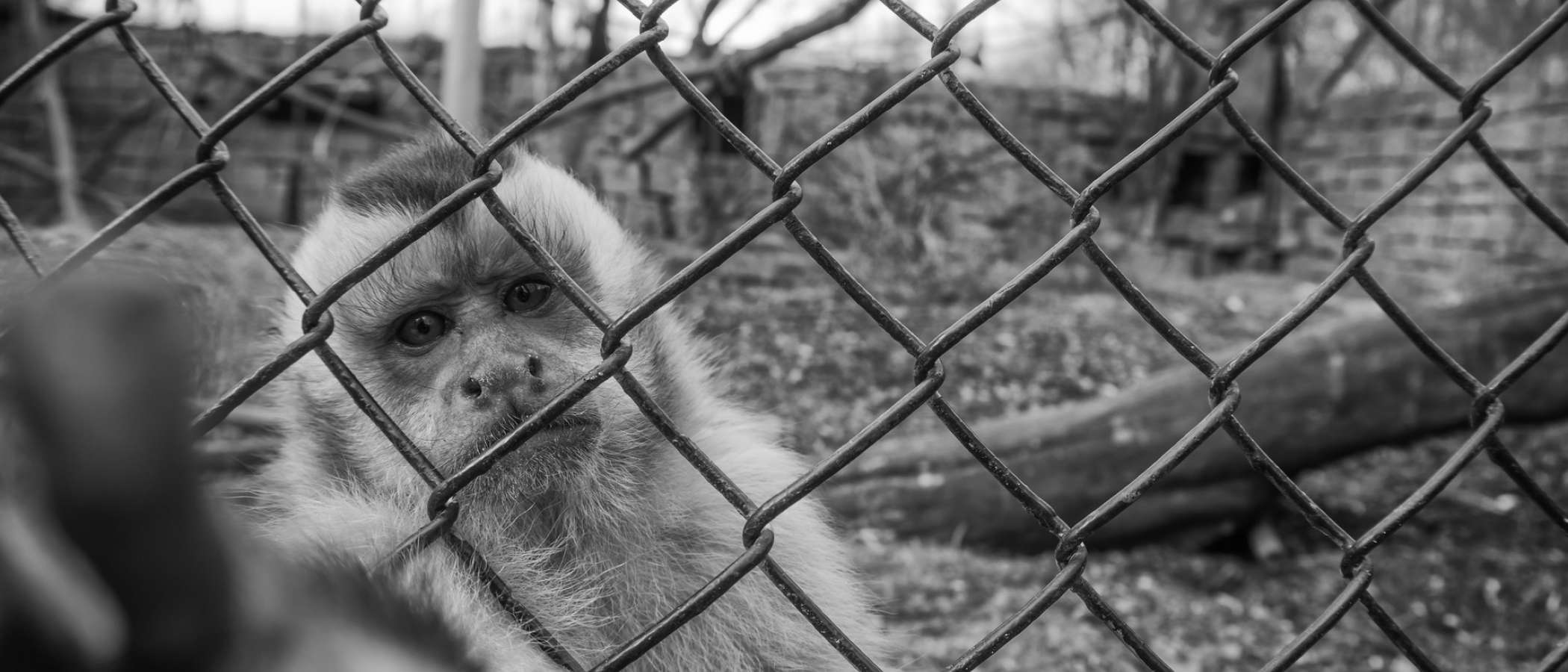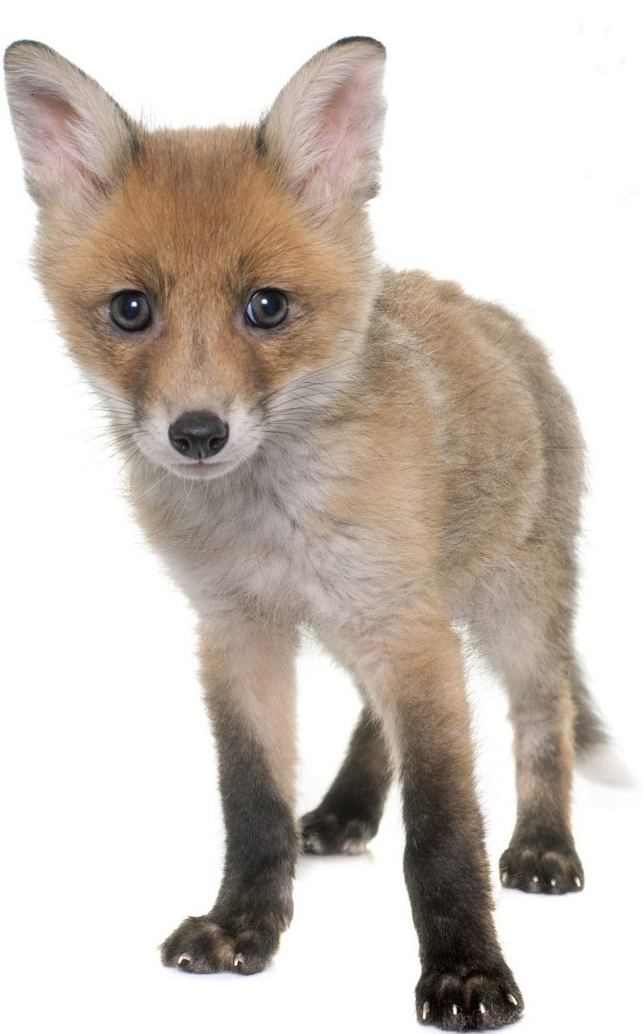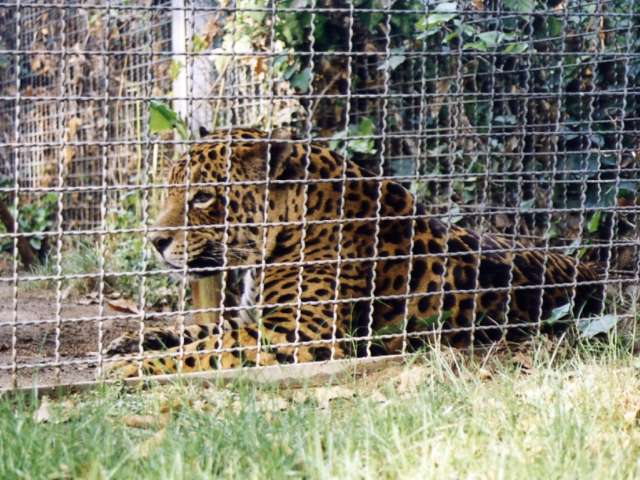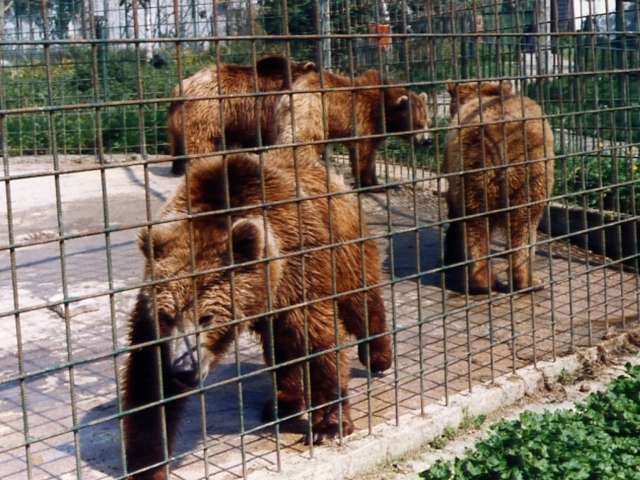We denounce
- Abandonment. Causes and Consequences
- Alternative methods to animal experiments
- Animals in circuses
- Breeding and hunting animals to show off their fur or skin
- Captivity shows and therapies
- Experimenting with animals
- Hunting, capturing and trafficking
- Intensive animal breeding
- Torture shows
- Transport over long distance or in bad conditions
- Zoos are like prisons
Zoos are like prisons

Zoos are captivity and entertainment centres where collections of wild animals are exhibited in solitary, often in solitary confinement, with the main aim of satisfying the curiosity of visitors.
Animals exhibited in these facilities are subject to complete control and live in very different conditions from those in which they live in the wild. Captivity suppresses the natural instincts of wild animals. Animals suffer permanent frustration because they have no freedom of choice and cannot behave as they would do in their natural environment. This leads to a tendency toward genetic, physical and behavioural degeneration.
The consequences of captivity are:
Stereotypical behaviours: these are pathologies stem from forced captivity and are expressed through obsessive and / or repetitive behaviours including:
- continually walking around.
- turning in circles.
- playing with their tongue.
- biting and licking the bars.
- turning the neck, swinging,
- shaking the head up and down,
- rocking, hugging their legs, (common in big cats, elephants, bears, giraffes, camels, primates, etc.).
Other pathologies:
- Apathy, sadness, boredom.
- Eating Disorders (they refuse to eat or, on the contrary, become obsessed about food).
- Self-mutilation (biting tail, legs, head banging)-cats, bears, primates.
- Excessive cleaning (pulling hair or feathers off, leaving their skin with patches)-bears and parrots.
- Abnormal sexual behaviours (hyperactivity, finding substitute objects).
- Abnormal maternal behaviour (mothers attack, kill or abandon their young, etc.).
- Prolonged childish behaviour (immaturity, abnormal social behaviour, lack of social trust, etc.).
- Abnormal aggression: (with more intensity or frequency as a result of overcrowded cages, threats of dominant animals and pressure from zoo visitors.
- Vomiting and regurgitation, repeated vomiting, eating vomit and regurgitating. (often in gorillas and chimpanzees).
- Coprophagie: playing with and / or eating faeces, smearing faeces on walls (gorillas and chimpanzees).
- Many kind of diseases (digestive, skin, respiratory, cardiovascular, ...).
Abnormal behaviour and some of the illnesses suffered by captive animals are caused by:
- The inability to properly develop their own guidelines and natural impulses.
- Idleness, boredom and forced frustration.
- Permanent stress.
- Direct control by humans and loss of self-control.
- Loss of normal modes of living either as part of a normal social group or with solo status.
- Medications and medical management of fertility programs.
- Caging in a totally strange habitat.
- Type of infrastructure, artificial lighting, predictable diet on a routine basis, noise and strange colours.
- Unnatural proximity to other animals and human visitors.
- Being taken away of their natural habitat.
Their influence on conservation:
- 6,000,000 living animals are estimated to live in captivity for human entertainment.
- Less than 10% of captive animals kept in zoos are endangered species.
- So far zoos are not providing animals or money for reintroduction programs.
- The most significant boost in reintroduction programs of animals to the wild have been awareness campaigns, government programs and the pressure from conservation movements.
- Re-introduction projects for the conservation of a species will only be successful if they are carried out over longer periods of several years and if a large number of animals are released.
- The abnormal behaviour of animals, acquired in captivity (zoos) is a negative factor for reintroduction in nature, since it reduces the chances of survival.
- According to data released by the English organisation the RSPCA on a report on elephants, the majority of the 500 elephants kept in captivity in European zoos were caught in the wild.
- Despite being protected, dolphins are being caught in the wild to be kept in zoos.
- Zoos and education.
- Zoos perpetuate the image of the animal as an object and that human beings have dominion over other species.
- It is a contradiction that to achieve the goal of educating, the method used is the example of animals who are subjected to captivity.
- They promote the message that humans can build and reinvent nature.
- The interest is limited to visual and momentary satisfaction without achieving any real knowledge or special interest in wildlife.
- The circus shows mislead even more the public perception because animal are forced into unnatural behaviours.
- They do not raise awareness on the preservation of ecosystems and natural parks, both of vital importance for the survival of the species.
Conclusions:
- Zoos have failed to make significant contributions in the conservation of endangered species, or the protection of their natural habitats.
- Captive breeding in these facilities for wildlife conservation purposes is not a relevant strategy in all its actions.
- Zoos do not educate the public about how to help to protect and conserve the species.
- They continue to perpetuate a negative image of the use of animals for entertainment.
- Many animals in zoos live in unacceptable conditions.
- No priority is given to the physical and mental well-being of animals.
- In many ways zoos are not the solution but part of the problem.
Animal welfare is a priority and must prevail over other issues. That is why any decision taken by a zoo should first consider the effect on the animals and to giving them the maximum comfort within the best environmental conditions and allowing them to express a more natural behaviour, given that very few of them will have the chance to be reintroduced in nature. They should take into account the opinion and allow the participation of animal welfare organizations and environmental groups as important partners in improving animal welfare and care.
- Animals must be moved to more appropriate environments designed to satisfy their needs, giving the priority to species that most suffer in captivity (elephants, felines, etc..) in order to minimize the negative effects of captivity .
- The use of animals in circus shows in which they are forced to perform unnatural behaviours must be stopped.
- Zoos should not support the captivity of wild species.
- The authorities should monitor and ensure compliance with the provisions of existing legislation to improve conditions for animals and public safety.
- When a zoo is closed down, it is necessary to ensure the best new facilities to which the animals may be relocated.
- Since a majority of captive breeding programs are not feasible or effective in the preservation of species, animals in captivity should not breed. All efforts and funds should be invested in the protection and conservation of natural habitats and species.
- When captive breeding is the only viable option to preserve a species, breeding programs “in-situ " should be established.
WHAT YOU CAN DO
- If you visit any of these facilities do it as a critical observer, analyzing the situation and conditions of animals located there.
- Ask for more information. ADDA provides information and awareness raising materials
- If you want to collaborate more actively: BECOME A ZOO INVESTIGATOR Contact ADDA and we will send you a form.
- The more eyes and ears we have to help things change, the more relief will be brought to captive animals. Your help is important to gather as much information as possible.
NGO ADDA is a founding member of ENDCAP www.endcapivity.org
NGO ADDA has conducted several campaigns, trying to raise awareness for a change of mind to end suffering and unjustified captivity. Many actions have been undertaken: Complaints, visits to zoos, reports, conferences and workshops, investigations, studies and submission of amendments to legislation an, partnerships with international organization.






